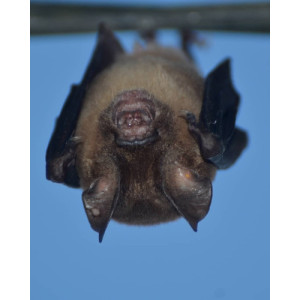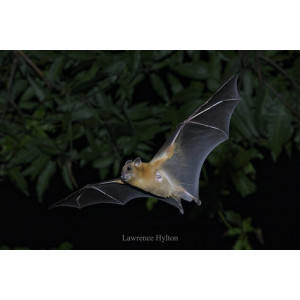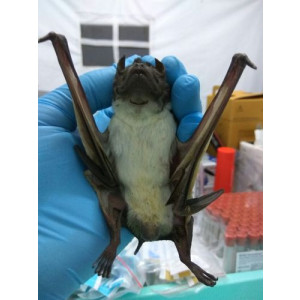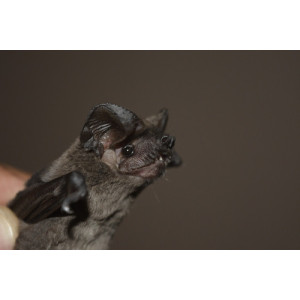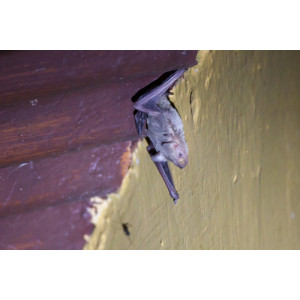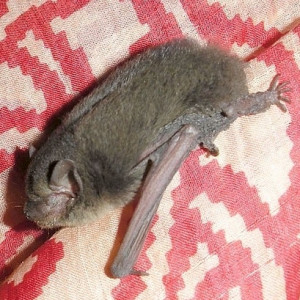@jakob

Least Leaf-nosed Bat Did you see this animal?
Scientific Name : Hipposideros cineraceus
Family : Hipposideridae
Order : Chiroptera
Class : Mammalia
Phylum : Chordata
Other Name : Ashy Roundleaf Bat
Habitat : Forest, Caves and Subterranean Habitats (non-aquatic)
Description : The Least Leaf-nosed Bat is a small bat, with a wingspan of around 20 cm and a body length of 5-7 cm. It has a distinctive leaf-like structure on its nose that is used for echolocation. Its fur is typically brown or grey-brown in color.
The Least Leaf-nosed Bat uses echolocation to navigate and find prey. It emits high-frequency sounds that bounce off objects and are then detected by the bat's sensitive ears. The leaf-like structure on its nose helps to focus the sound waves and improve its echolocation ability.
The Least Leaf-nosed Bat is an insectivorous species, and primarily feeds on moths, beetles, and other flying insects.
The Least Leaf-nosed Bat is found in a variety of habitats, including deserts, grasslands, and forests. It is known to roost in caves, mines, and buildings.
The Least Leaf-nosed Bat is a nocturnal animal and is active mainly at night. It is known for its agile flight and is able to maneuver through cluttered environments with ease. It is a social species, and is often found roosting in groups. They are migratory, moving between summer roosts and winter hibernacula. These bats may travel up to 400 km between their summer and winter habitats.
The Least Leaf-nosed Bat is classified as a species of "least concern" by the International Union for Conservation of Nature (IUCN). However, like many bat species, it is threatened by habitat loss and degradation, and its populations in some parts of its range have declined.
The Least Leaf-nosed Bat uses echolocation to navigate and find prey. It emits high-frequency sounds that bounce off objects and are then detected by the bat's sensitive ears. The leaf-like structure on its nose helps to focus the sound waves and improve its echolocation ability.
The Least Leaf-nosed Bat is an insectivorous species, and primarily feeds on moths, beetles, and other flying insects.
The Least Leaf-nosed Bat is found in a variety of habitats, including deserts, grasslands, and forests. It is known to roost in caves, mines, and buildings.
The Least Leaf-nosed Bat is a nocturnal animal and is active mainly at night. It is known for its agile flight and is able to maneuver through cluttered environments with ease. It is a social species, and is often found roosting in groups. They are migratory, moving between summer roosts and winter hibernacula. These bats may travel up to 400 km between their summer and winter habitats.
The Least Leaf-nosed Bat is classified as a species of "least concern" by the International Union for Conservation of Nature (IUCN). However, like many bat species, it is threatened by habitat loss and degradation, and its populations in some parts of its range have declined.
Distribution in Bangladesh
References:
description written by:Asad U. Tanvir,Department of Zoology,Jagannath University,Dhaka; reviewed by:Muntasir Akash,Department of Zoology,University of Dhaka;Taxonomic Checklist:Red List of Bangladesh Volume 2: Mammals, 2015, IUCN; information sources:wikipedia,iucnredlist.org; photo credit:jakob(www.inaturalist.org/people/jakob), photo copyright: iNaturalist.more information please contact with us.
description written by:Asad U. Tanvir,Department of Zoology,Jagannath University,Dhaka; reviewed by:Muntasir Akash,Department of Zoology,University of Dhaka;Taxonomic Checklist:Red List of Bangladesh Volume 2: Mammals, 2015, IUCN; information sources:wikipedia,iucnredlist.org; photo credit:jakob(www.inaturalist.org/people/jakob), photo copyright: iNaturalist.more information please contact with us.

